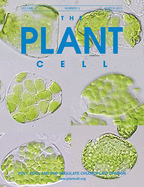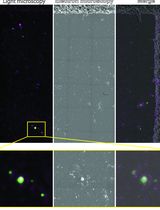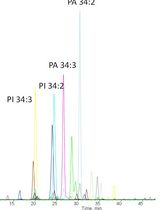- EN - English
- CN - 中文
Measurement of PI4P Levels in Intact Chloroplasts Isolated from Arabidopsis thaliana
测量从拟南芥中分离的完整叶绿体中的PI4P含量
发布: 2016年02月05日第6卷第3期 DOI: 10.21769/BioProtoc.1719 浏览次数: 10219
评审: Tie LiuYingnan HouArsalan Daudi
Abstract
Phosphatidylinositol 4-phosphate (PI4P), a major species of phosphoinositides, modulates many fundamental cellular processes. We have recently revealed that PI4P plays an important role in chloroplast division as a negative regulator. Despite its importance in chloroplasts, the content of PI4P in chloroplasts is very low and it is difficult to measure PI4P levels. In this protocol, we describe a simple method that we have developed for measurement of low level of PI4P in chloroplasts. Intact chloroplasts were isolated by a basic method using Percoll gradient centrifugation and acidic lipids were extracted from the isolated chloroplasts. The extracted acidic lipids including PI4P were spotted onto the membrane strip, which had been pre-spotted with PI4P standards and other phosphoinositides as negative controls. PI4P in the spot of acidic lipids on the membrane was detected using a PI4P binding protein.
Keywords: Phosphatidylinositol 4-phosphate (磷脂酰肌醇磷酸)Materials and Reagents
- Isolation of intact chloroplasts
- Miracloth (Merck Millipore Corporation, Calbiochem®, catalog number: 475855 )
- Gauze (Hakujuji Co., model: FC-gauze )
- Seedlings of Arabidopsis thaliana
Wild-type (Columbia-0) plants, phosphatidylinositol 4-kinase (PI4K) α1 knockdown plants, pi4kβ2-1 mutants and PI4Kα1 knockdown plants of pi4kβ2-1 mutants were grown for 4 days on MS agar plates and then transferred onto agar plates with or without 5 μM dexamethazone (DEX) and grown for 1 week. The down-regulation of PI4Kα1 expression was induced by DEX treatments in PI4Kα1 knockdown plants and PI4Kα1 knockdown plants of pi4kβ2-1 mutants. For treatments with inhibitors, wild-type 4-d-old seedlings were transferred onto agar plates with PI4K inhibitors, 200 μM wortmannin (WM) or 25 μM phenylarsine oxide (PAO), or a phosphatidylinositol 3-kinase (PI3K) inhibitor, 50 μM LY294002 (LY), or without inhibitors (DMSO) and grown for 3 days. - Percoll (GE Healthcare, Dharmacon, catalog number: 7-0891-01 )
- Bradford assay kit (Bio-Rad Laboratories, catalog number: 500-0006JA )
- 1x protease inhibitor cocktail (Nakarai, catalog number: 03969-21)
Note: Currently, it is “Nacalai tesque, catalog number: 03969-21 ”. - Sorbitol
- HEPES-KOH (pH 7.5)
- EDTA
- Grinding buffer (see Recipes)
- 80% Percoll or 40% Percoll (see Recipes)
- Miracloth (Merck Millipore Corporation, Calbiochem®, catalog number: 475855 )
- Extraction of PI4P
- 0.75 M Trichloroacetic acid (TCA) (Wako Pure Chemical Industries, Siyaku, catalog number: 203-04952 )
- 5% (w/v) TCA with 1 mM EDTA
- Methanol (Wako Pure Chemical Industries, Siyaku, catalog number: 137-01823 ): Chloroform (Wako Pure Chemical Industries, Siyaku, catalog number: 038-02601 ) (2:1, v/v)
- Methanol: chloroform: 12 N HCl (Wako Pure Chemical Industries, Siyaku, catalog number: 080-01066 ) (80:40:1, v/v/v)
- 0.75 M Trichloroacetic acid (TCA) (Wako Pure Chemical Industries, Siyaku, catalog number: 203-04952 )
- Measurement of PI4P levels
- PI(4)P Mass Strip Kit (Echelon Biosciences, catalog number: K-4000E )
- Albumin from bovine serum (BSA), fatty acid free (Wako Pure Chemical Industries, Siyaku, catalog number: 017-15146 )
- HRP substrate solution (Thermo Fisher Scientific, Pierce, catalog number: NCI32132 )
- Phosphate (pH 7.4)
- NaCl
- 0.1% (w/v) Tween-20
- Phosphate buffered saline (PBS) (see Recipes)
- PBST (see Recipes)
- PI(4)P Mass Strip Kit (Echelon Biosciences, catalog number: K-4000E )
Equipment
- Homogenizer (Microtec Co., model: NS-51 )
- Centrifuge (TOMY SEIKO CO., models: MX-200 and GX-250 )
- Swing rotor (TS-7C)
- Paintbrush
- Pasteur pipette (Sansyo, Iwaki, catalog number: IK-PAS-9P )
- Vacuum dryer (Centrifuge evaporator) (Shimadzu Corporation, model: SPE-200 )
- Sonicator (SHARP CORPORATION, model: UT-106 )
Procedure
文章信息
版权信息
© 2016 The Authors; exclusive licensee Bio-protocol LLC.
如何引用
Okazaki, K., Miyagishima, S. and Wada, H. (2016). Measurement of PI4P Levels in Intact Chloroplasts Isolated from Arabidopsis thaliana. Bio-protocol 6(3): e1719. DOI: 10.21769/BioProtoc.1719.
分类
植物科学 > 植物生物化学 > 脂质
生物化学 > 脂质 > 脂质测定
您对这篇实验方法有问题吗?
在此处发布您的问题,我们将邀请本文作者来回答。同时,我们会将您的问题发布到Bio-protocol Exchange,以便寻求社区成员的帮助。
Share
Bluesky
X
Copy link













